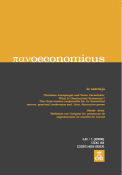The Yield Curve as a Leading Indicator of Recession: Austrian Economics Insights
DOI:
https://doi.org/10.2298/PAN230217018AKeywords:
Yield curve , Austrian business cycle theory , Monetary policy , Macroeconomics , Political economyAbstract
This is a heterodox review on macroeconomics according to the Austrian Economics. The Austrian business cycle theory explains the origin of boom-bust cycles based on the difference between natural interest rates and banking rates, which comes from the artificial processes of monetary and credit expansion. This difference is the yield curve, an instrument to detect the deviation of monetary policies, and a forward indicator of business cycles. This article studies the impact of yield curve slope on the requirements for access to bank credit, and the distorting effect of expansionary monetary policies on the capital structure. In an environment of artificially low interest rates, these distortions become an accumulation of long-term failed investments that markets cannot assume, with the consequent readjustment or recession. To detect these distortions and to control the bust, it could be useful the yield curve illustrates here.
JEL: B5, E3, E5, F4.






